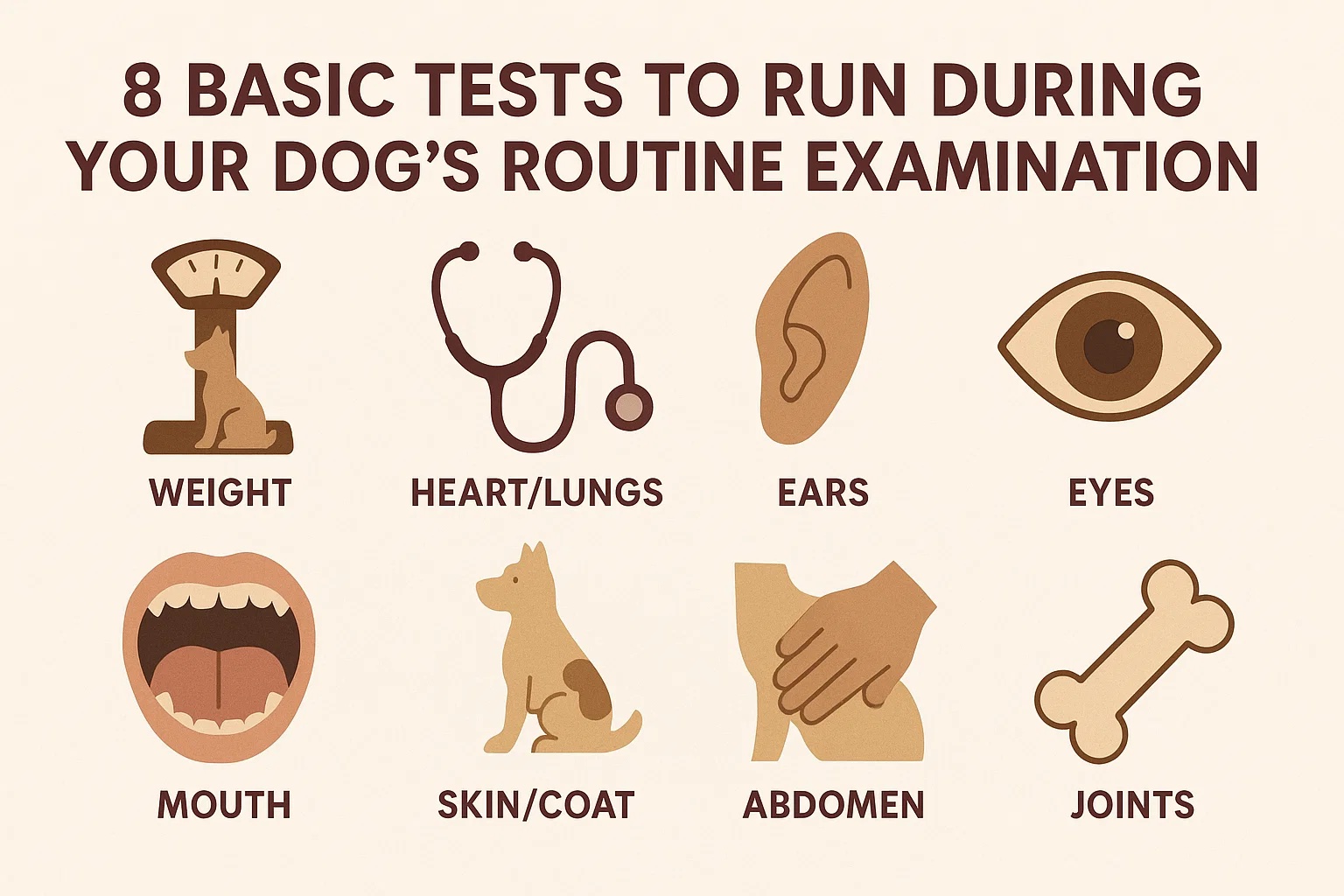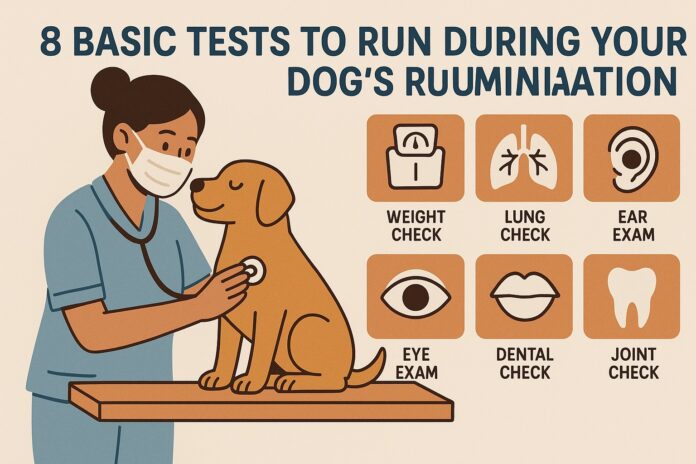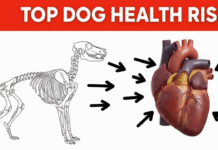Last Updated on May 16, 2025 by Dogs Vets
8 Basic Tests to Run During Your Dog’s Routine Examination
A physical examination is an essential examination every dog should have at least once a year. However, some people wrongly believe that you should examine your dog only when it seems sick. It may be too late in some cases, as many diseases are asymptomatic until they develop into severe stages.
“An ounce of prevention is worth a pound of cure,” and by knowing what tests to run routinely, you can prevent serious health issues (you can visit My Sweet Puppy Guides for more information about the most common health problems in dogs) from evolving in your dog. Besides, prevention and treatment in the early stages of every disease are much cheaper.
Thus, you should know what necessary tests you need to get for your pet. Read on and find out why your vet should regularly auscultate your pet’s heart, look for hair loss on its ears, palpate lymph nodes, and more!

Heart Rate
Normal vital signs depend on a dog’s size. For small dogs and puppies normal heartbeat of 120 to 160 beats per minute, while large breeds will have heart rates of 60 to 120. An examination of the heart is one of the most important tests that your vet performs because a lower pulse can indicate problems with your pet’s heart, kidneys, or liver.
In addition, a rapid pulse can be a symptom of a cardiac problem. Sometimes, dogs with a disease in their hearts don’t show any signs in the early stages. That’s why you must also have an ultrasound of the heart to check for any abnormalities.
Arterial Blood Pressure
A basic examination should include a blood pressure test. The vet first attaches a cuff with a tube with sensors inside to your pet’s upper leg. The cuff inflates and repeatedly deflates until it finally starts inflating on its own. This indicates that the sensors are working correctly.
The vet then presses a button on the machine attached to the cuff and waits for the results. If they see anything abnormal on the screen, you should get an ultrasound of the heart as well as abdominal x-rays and other tests if necessary.
Hair Loss
A common sign of allergies in dogs is hair loss on the ears, face, and neck. It can also be caused by tumors found in those areas of your dog’s body. If your dog shows any of these symptoms, take it to see the vet immediately for a thorough examination. It is crucial to first rule out all possible causes, including fleas, ticks, parasites, bacteria, viruses, fungi, etc., before starting treatment.
Your pet’s veterinarian will run some tests to ensure that there are no cancerous cells in those areas. They will also run some tests to ensure that no mites are causing the hair loss, bacterial infections causing irritations (such as scrapes), etc., before diagnosing your dog with allergies.
The vet will apply some allergy tests such as intradermal skin testing and intradermal serum testing to help them make a diagnosis. In other words, they will prick small amounts of allergens under the skin and observe if your dog develops allergies or not. If not, they will prick larger amounts until they find out which allergen caused that reaction. Your vet will then treat your dog accordingly based on their findings from these tests.
Lymph Nodes
Lymph nodes are located in the neck, chest, abdomen, etc. You can feel them easily when you touch your pet’s body. Your dog’s vet will palpate its lymph nodes to check if they are enlarged or not. They will also run other tests to determine the cause of the enlargement.
A lymph node enlargement isn’t always cancerous, but it can indicate cancer in some cases. Certain types of cancer are notorious for causing lymph nodes to swell up in dogs and cats – lymphoma and leukemia, for example. Sometimes, it may be due to infections instead of cancerous tumors. Still, it is crucial to see a veterinarian immediately and start treatment (if needed) before it spreads elsewhere in the body and becomes untreatable later on.
Lymph node enlargement may also indicate inflammatory conditions such as parasites, infections, etc., so your vet will need to run more tests to come up with a definitive diagnosis for your pet’s condition.
Ear Exam
The veterinarian will also auscultate your pet’s ears, as ear infections in dogs and cats are very common. They can be caused by bacteria, yeast, mites, mold, etc., and can be treated with medications prescribed by the vet. If left untreated, it may become chronic and can cause permanent damage to your dog’s hearing.
Your dog may scratch its ears due to itchiness, so you should regularly check for any redness or swelling around the ears. A proper exam of the ears should include checking for parasites, discharge from the ears, crusts or crusty debris in the ears, redness around the ear canal, and any other abnormalities. Aural hematoma (swelling of inner ear tissues) is another common condition that your vet might find during the examination.
Skin Examination
Skin problems are also widespread in dogs and cats. In fact, many dog skin infections are contagious to humans through saliva, urine, feces, or the coat. Therefore, it’s imperative to check your dog for any skin issues.
Sometimes, they are caused by allergies, fungal infections, bacterial or viral infections, etc. Some skin problems can lead to more serious conditions such as cancer, so your pet’s vet must do a thorough examination before diagnosing your pet with any disease. The veterinarian will do a thorough check of your dog’s skin for any abnormal lumps, bumps, rashes, etc., before giving you a diagnosis.
Hair Pluck Test
It is an easy and effective test used for various disease processes – from infections and parasitic conditions (for example, dermatophytosis) to alopecia and other skin conditions. It involves plucking some hairs from diseased parts of your dog’s body determined by previous dermatological examination.
The veterinarian will use a microscope to examine these hair tips, which makes it a fast and inexpensive test to evaluate if your dog experiences hair loss because of rubbing or licking due to some health issues.
X-Rays and Ultrasound
Dogs and cats can get cancers in their bodies just like humans do. They can also get bone tumors, infections from bacteria and viruses, cancerous tumors in their lungs due to squamous cell carcinoma (SCC), etc. That’s why regular x-ray examinations are essential to ensure that your pet is healthy. Your vet will use x-rays to scan your pet’s body for any abnormalities, like tumors, bone fractures, arthritis, dental problems, etc.
Conclusion
When it comes to taking care of your pet, it is crucial to understand the importance of regular checkups at the veterinarian and not neglect running additional tests and examinations if suggested by the specialist. It will allow you to detect any possible health issues in your dog in its early stages and, with prompt treatment, prevent them from evolving into severe health conditions.
Besides, in addition to keeping your dog healthy and your mind at peace, you also have higher chances to avoid expensive treatments later on if you address the issues immediately.
Fact Check
We strive to provide the latest valuable information for pet lovers with accuracy and fairness. If you would like to add to this post or advertise with us, don’t hesitate to reach us. If you see something that doesn’t look right, contact us!

















